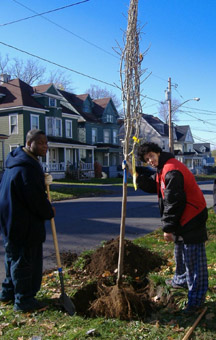Cornell helps trees grow in towns from Medina to Jordan by advising N.Y. communities on managing urban forests
By Krishna Ramanujan

How much is a tree actually worth? Well, consider how the common urban tree not only benefits the local ecosystem, provides shade and helps reduce energy costs, but also stirs the soul by improving the aesthetic quality of an area.
"We've worked in 16 communities over the last four years," said Bassuk. "Some of them have really developed active tree commissions." She cites the city of Medina, which has organized a tree board and passed a tree protection ordinance; Red Hook, which has developed a master plan and Web site; and Williamsville, near Buffalo, which has taken an inventory of its trees.
In addition, Bassuk and Cornell Cooperative Extension (CCE) of Onondaga County have trained both students and volunteers to conduct tree inventories for municipalities. Bassuk and her colleagues use the data to create 10-year master plans for those communities to help them prioritize removals and plantings to keep their urban forests diverse and healthy.
Bassuk and colleagues from Onondaga's CCE, for example, have trained a Student Weekend Arborist Team (SWAT), which includes students from Cornell, to take tree inventories in the villages of Jordan, Liverpool, East Syracuse and Fayetteville. The inventories inform the communities where and what types of trees are planted in their urban forests. They have determined that maples make up 60 to 75 percent of Onondaga County's urban trees, and 30 to 60 percent of trees in towns statewide are of the same species, making these trees susceptible to pests and disease outbreaks.
Using the tree census data, the U.S. Forest Service has calculated dollar values for a community's tree resources. For example, trees save Fayetteville more than $1,600 in ecosystem services by improving air quality and removing carbon monoxide, ozone, nitrogen dioxide, particulate matter and sulfur dioxide. If the town were to replace all the trees in its urban forest, it would cost over $5 million.
Trees also save communities money by providing shade and reducing urban heat island effects caused by roads and buildings that absorb the sun's energy and release it into the air as heat.
"A rooftop could be 160 degrees Fahrenheit in the middle of the summer, and that is going to make cooling that building a lot more expensive than if you had a rooftop garden," said Stephen Harris, resource educator in urban and community forestry for the CCE of Onondaga County.
The British power company National Grid, which owns several energy providers in the Northeast, also is interested in the data, particularly on trees requiring regular pruning under power lines.
Bassuk also has developed a bare-root tree transplanting system for 8- to 12-foot-tall trees with exposed roots. Bare-root trees survive transplantation about as well as balled and burlapped trees do, and the cost is only about $80. The method cuts a municipality's costs for buying, transporting and planting trees by two-thirds. It can cost on average $250 to buy and plant a heavier, more expensive burlap bottom tree (whose roots are covered by dirt and burlap) that often requires machinery and professional tree planters.
Bare-root tree planting is taught in one CCE program, CommuniTree Stewards, which trains an average of 40 citizen volunteers per year in Onondaga County; the program provides 10 hours of training in exchange for 15 hours of community service.
"When citizens are involved in planting they care more," said Harris. "The program is a win-win for communities because they can buy more trees, engage residents to plant them, and then residents can take care of them afterwards."
To restore the very low tree cover in a poor neighborhood of Syracuse, CCE partnered with a community development organization, the Southside Neighborhood Action Group, or SNAG, to form the Onondaga Earth Corps, a youth leadership and employment program. Neighborhood youth were trained to conduct street-tree inventories and to lead more than 70 residents and other volunteers in planting 115 trees, including 35 on the grounds of an elementary school that had only five trees.
In such ways Cornellians carry out the university's land-grant mission to transfer knowledge from the university to the community and open a dialogue between Cornell and those outside the campus. Although four Cornell colleges operate as contract colleges through the state, all of Cornell is New York's land-grant university.
Media Contact
Get Cornell news delivered right to your inbox.
Subscribe